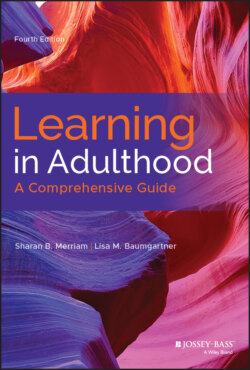Читать книгу Learning in Adulthood - Sharan B. Merriam - Страница 35
Community-Based Learning
ОглавлениеMost nonformal education takes place in community settings such as museums, hospitals, libraries, and so on; thus, “community-based learning” is often used interchangeably with “nonformal learning.” The most defining characteristic of community-based learning is its focus on issues of importance to the community. People gather in churches, the community center, or the local library organizing to overcome a specific problem or issue they believe to be important in improving life in their community. These problems have ranged from addressing racial hatred and inequality to ensuring adequate housing and sanitary living conditions. Other images of community-based learning programs include men and women learning to read and write while at the same time gaining marketable job skills, adults learning CPR at the local Red Cross, farmers being introduced to new methods and crops as a way to build economic control over their lives, and spouses who batter being taught nonviolent ways of handling their anger and frustration. “Civic engagement” is often the goal of community-based learning (see for example, Reed and Marienau's 2008 New Directions in Adult and Continuing Education issue, Promoting Civic Engagement Through Community-Based Learning). Community-based learning is also often used interchangeably with “service learning” to mean engaging students in formal education with their local community.
One common goal of many of these programs is their focus on social action and change for the betterment of some part of the community. Chickering (2008) makes the case that community engagement is necessary for strengthening democracy:
We need to strengthen and sustain a multicultural, multiethnic, multireligious, internationally interdependent, pluralistic democracy. We need to identify and support policies, practices, and resource allocations that anticipate the dislocations and disruptions that will accompany global warming and the steady depletion of oil reserves. We need to contain and help ameliorate recurrent intertribal, interethnic, and interreligious conflicts. We need to address basic issues concerning public education, health care, and an aging population. We need to create a globally recognized example of participatory government where all persons, regardless of socioeconomic status, race, national origin, or religious and spiritual orientation, are actively involved (p. 88).
There are many examples of community-based programs such as stimulating community-building through community education in Hungary (Dobos, 2016), promoting family well-being in public housing in Hong Kong (Chu et al., 2018), and community-based lifelong learning for sustainable development (Noguchi, Guevara, & Yorozu, 2015). Educators who work in these programs believe that education and training can be a powerful tool in assisting learners to take control over their own lives. Sometimes these programs are not welcomed by the mainstream community, especially if one of their main purposes is to challenge the existing way of life, including the current social and economic structures of that community. Vivid examples include the worldwide human rights movement, the continuing struggle to eliminate poverty and hunger, community-based actions exposing hazardous waste dumps or polluted drinking water, enabling immigrants to integrate within a community, and local attempts to end discriminatory practices based on race, class, gender, sexual orientation, and so on.
Working with adults in community-based learning settings has both its blessings and its curses. Flexibility in administration and programming is often recognized as its greatest benefit. Because these types of organizations “start small and are typically organized as freestanding organizations with fairly simple structures …, they can often move relatively quickly to identify problems and develop programmatic solutions” (Hemphill, 1996, p. 21). This can translate into quicker response times, in terms of both developing funding proposals and getting resources to where they are needed. “New people can be brought in (or unfortunately let go more quickly) as needed. Curricula can be rapidly developed or revised. Teaching assignments can be quickly modified” (p. 22). Being able to move more quickly does mean that checks and balances must be in place to ensure both a focused program direction based on community needs and high-quality learning opportunities that are useful. In addition, people attracted to community-based adult learning programs, whether paid or volunteer staff, often come with a passion for a cause that gives them the drive to stay with this work, even under the most trying conditions. On the downside, the very nature of many community-based organizations often puts them on the path to an unending search for resources. This continuing search for and worry about resources, in combination with long and often difficult working conditions, can lead to staff burnout very quickly, even for the most committed individuals.
